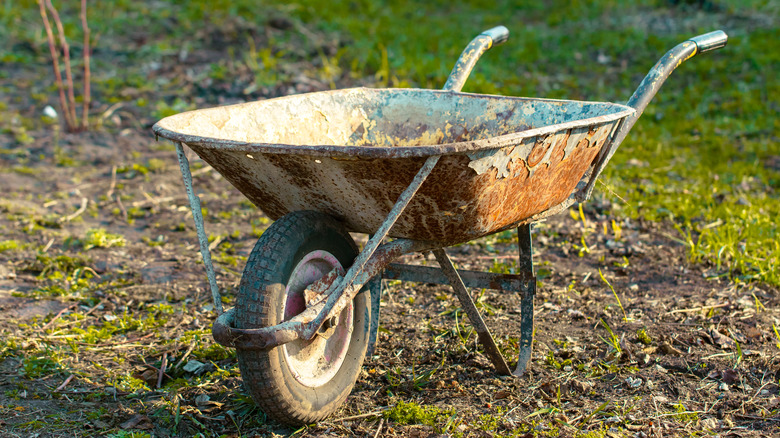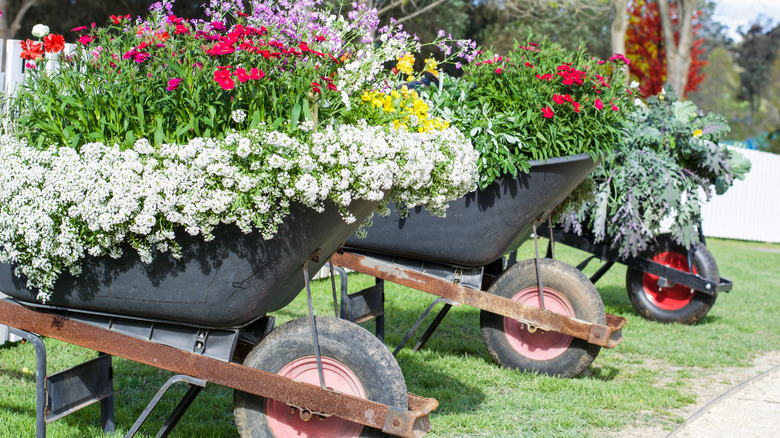Repurpose An Old Wheelbarrow Into A Stunning Cottage Garden Feature
Seeing that old wheelbarrow gathering dust and rust in your shed — you can't help but feel its days of toiling in the garden might be over. Rust lines its tray, and its wheel, having suffered one too many punctures, is looking pretty beaten. But hold that thought before you consign it to the landfill. With a bit of elbow grease and creativity, your old wheelbarrow can assume a second life as a mobile flower display, sprinkling a dash of extraordinary color into the familiar landscape of your cottage garden. It's pretty straightforward: spruce up the barrow, punch a few drainage holes, pack in enriched potting soil, then nestle in the flowers you love best. So, if you've been wondering if you can plant flowers in a rusty wheelbarrow, here's your green light.
You're not just pinching pennies here. This hack for repurposing old garden tools hits a sweet spot of sustainability and creativity. Instead of sending more material to the landfill, you're breathing life into something readily available to you. Plus, imagine the biodiversity boon. Your DIY cottage garden feature, brimming with a riot of flowers, becomes an elevated hotspot for bees, butterflies, and even the occasional hummingbird. And let's not gloss over the versatility this DIY brings. You can wheel it to wherever your gardening fancies take you — Follow the sunlight, shift with the changing seasons, or simply stir things up for a fresh view.
How to turn an old wheelbarrow into a cottage garden planter
This quest to create a rustic planter for your cottage garden begins by gathering the basics: an old wheelbarrow, drill, potting soil, plants, and compost. First up, tackle any rust with a wire brush and hardened chunks of cement with a steel scraper. Make sure the wheelbarrow is clean before moving on. Next, grab your drill and make ¾-inch wide holes, 5 inches apart, at the bottom of the wheelbarrow. These are super important for drainage and keeping root rot at bay. Now, for the fun bit, get that wheelbarrow filled up with potting mix and enrich it with mature compost. Stir up the two ingredients with a garden fork or shovel, like whipping up a gourmet meal for your flowers.
Thoughtfully select the plants for your wheelbarrow planter. From verbenas and petunias cascading down the sides for some drama, dwarf canna lilies (or snapdragons) adding a bit of height and elegance, and sedums to tough it out through thick and thin. It's all about getting that mix right to mirror the spontaneous cottage garden vibe you're seeking. When it's time to plant, just use your hands to make holes in the soil mix in which you nestle your flowers. Ensure each plant has enough room to breathe and flourish. For the grand finale, wheel the repurposed wheelbarrow to a spot in your cottage garden where it can bask in the sun and grab attention.
Extra considerations for a DIY wheelbarrow planter
Skip the need to drill if your wheelbarrow is already sporting a few natural drainage points–courtesy of rust. But if those holes are excessively large, lining the base with non-woven geotextile fabric is a genius move to keep the soil in yet let excess water flow out. If that's not an option, a piece of coffee filter or paper towel on each hole will do the trick. And a coat of paint will give your wheelbarrow a total facelift. Use a bold or subtle color that vibes with your garden and protects against the elements. Perhaps consider the Rust-Oleum Professional High-Performance Rusty Metal Primer at The Home Depot ($49). And when the paint dries, why not slap on some stick-and-peel decals?
Remember, not every flower out there is a sun worshiper. Take Beesia, for instance; it's quite the opposite, perfect for shadowy parts of your cottage garden. Therefore, check the plant tags or hit up a quick search online for the light preferences before planting. Want flowers with different sunlight requirements in the same garden? Keep them in separate wheelbarrow planters to keep everyone happy. What if you could dial your project up even more? Picture your wheelbarrow lying on its side, half-filled with potting soil, with the rest spilling out into a petite stone-enclosed hill. Plant low-growing perennials, and voila — it'll look like they're happily growing on a hillside, fashioning a scene that'll make your garden the envy of guests and passersby.

